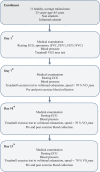Repeated bouts of exhaustive exercise increase circulating cell free nuclear and mitochondrial DNA without development of tolerance in healthy men
- PMID: 28542490
- PMCID: PMC5443547
- DOI: 10.1371/journal.pone.0178216
Repeated bouts of exhaustive exercise increase circulating cell free nuclear and mitochondrial DNA without development of tolerance in healthy men
Abstract
Objective: Acute single strenuous exercise increases circulating cell free DNA (cf DNA). We tested whether three repeated bouts of exhaustive exercise induced the cf DNA response without development of tolerance in healthy men.
Methods: Eleven average-trained men (age 34.0±5.2 years, body mass index 26.2±3.1 kg/m2, maximal oxygen consumption-VO2max 49.6±4.5 ml/kg*min) performed three treadmill exercise tests to exhaustion at speed corresponding to 70% VO2max separated by 72 hours of resting. Blood was collected before and after each bout of exercise for determination of cell free nuclear and mitochondrial DNA (cf n-DNA, cf mt-DNA) by real-time PCR, selected markers of muscle damage, and blood cell count.
Results: Each bout induced the increase (p<0.05) in plasma cf n-DNA: from 3.4±1.4 to 38.5±27.5, from 4.1±3.3 to 48.5±26.2, and 3.1±1.6 to 53.8±39.9 ng/mL after the first, second, and third exercise, respectively. In a congruent way, cf mt-DNA rose significantly after the second (from 229±216 to 450±228*103 GE/mL) and third bout of exercise (from 173±120 to 462±314*103 GE/mL). Pre-exercise cf mt-DNA decreased (p<0.05) by 2-times (from 355±219 before the first bout to 173±120*103 GE/mL before the third bout) over the study period and were accompanied by significant increase in white blood cells, platelets, creatine kinase, creatinine and lactate after each bout. However, the exercise induced percentage increment of cf n-DNA was always many times higher than corresponding increments of the afore-mentioned markers at any occasion.
Conclusions: Repeated bouts of exhaustive exercise induced remarkable increase in circulating cf n-DNA without signs of tolerance development. Baseline cf mt-DNA decreased in response to series of strenuous exercise. Since percentage increments of cf n-DNA in response to exercise were many times higher than those observed for other markers, measurement of circulating cf n-DNA could be a sensitive tool for monitoring acute exercise effects in human body.
Conflict of interest statement
Figures


Similar articles
-
Response of Circulating Free Cellular DNA to Repeated Exercise in Men with Type 1 Diabetes Mellitus.J Clin Med. 2024 Oct 1;13(19):5859. doi: 10.3390/jcm13195859. J Clin Med. 2024. PMID: 39407919 Free PMC article.
-
Decreased integrity of exercise-induced plasma cell free nuclear DNA - negative association with the increased oxidants production by circulating phagocytes.Sci Rep. 2019 Nov 4;9(1):15970. doi: 10.1038/s41598-019-52409-w. Sci Rep. 2019. PMID: 31685910 Free PMC article.
-
Circulating cell free DNA response to exhaustive exercise in average trained men with type I diabetes mellitus.Sci Rep. 2021 Feb 25;11(1):4639. doi: 10.1038/s41598-021-84201-0. Sci Rep. 2021. PMID: 33633280 Free PMC article.
-
Circulating cell-free DNA: an up-coming molecular marker in exercise physiology.Sports Med. 2012 Jul 1;42(7):565-86. doi: 10.2165/11631380-000000000-00000. Sports Med. 2012. PMID: 22694348 Review.
-
The effect of physical exercise on anticancer immunity.Nat Rev Immunol. 2024 Apr;24(4):282-293. doi: 10.1038/s41577-023-00943-0. Epub 2023 Oct 4. Nat Rev Immunol. 2024. PMID: 37794239 Review.
Cited by
-
Mitochondria Can Cross Cell Boundaries: An Overview of the Biological Relevance, Pathophysiological Implications and Therapeutic Perspectives of Intercellular Mitochondrial Transfer.Int J Mol Sci. 2021 Aug 2;22(15):8312. doi: 10.3390/ijms22158312. Int J Mol Sci. 2021. PMID: 34361078 Free PMC article. Review.
-
Response of Circulating Free Cellular DNA to Repeated Exercise in Men with Type 1 Diabetes Mellitus.J Clin Med. 2024 Oct 1;13(19):5859. doi: 10.3390/jcm13195859. J Clin Med. 2024. PMID: 39407919 Free PMC article.
-
Current Trends in Cell-Free DNA Applications. Scoping Review of Clinical Trials.Biology (Basel). 2021 Sep 13;10(9):906. doi: 10.3390/biology10090906. Biology (Basel). 2021. PMID: 34571783 Free PMC article.
-
Circadian rhythm and circulating cell-free DNA release on healthy subjects.Sci Rep. 2023 Dec 7;13(1):21675. doi: 10.1038/s41598-023-47851-w. Sci Rep. 2023. PMID: 38065990 Free PMC article.
-
Effect of acute moderate-intensity cycling on cfDNA levels considering menstrual cycle phases.Front Sports Act Living. 2024 Jan 29;6:1322295. doi: 10.3389/fspor.2024.1322295. eCollection 2024. Front Sports Act Living. 2024. PMID: 38348376 Free PMC article.
References
-
- Egan B, Zierath JR. Exercise metabolism and the molecular regulation of skeletal muscle adaptation. Cell Metab. 2013;17(2):162–84. doi: 10.1016/j.cmet.2012.12.012 - DOI - PubMed
-
- Coffey VG, Hawley JA. The molecular bases of training adaptation. Sports Med. 2007;37(9):737–63. - PubMed
-
- Bogdanis GC. Effects of physical activity and inactivity on muscle fatigue. Front Physiol. 2012;3:142 doi: 10.3389/fphys.2012.00142 - DOI - PMC - PubMed
-
- Brown WM, Davison GW, McClean CM, Murphy MH. A Systematic Review of the Acute Effects of Exercise on Immune and Inflammatory Indices in Untrained Adults. Sports Med Open. 2015;1(1):35 doi: 10.1186/s40798-015-0032-x - DOI - PMC - PubMed
MeSH terms
Substances
LinkOut - more resources
Full Text Sources
Other Literature Sources
Medical

